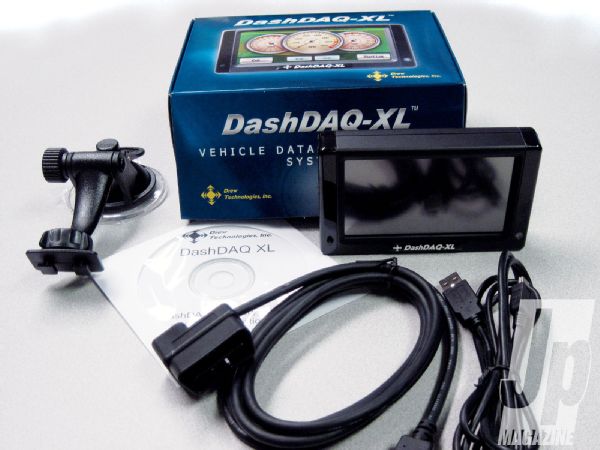
 Pete Trasborg
Brand Manager, Jp
Pete Trasborg
Brand Manager, Jp
When we got wind of the DashDAQ, we knew we'd have to try it. Drew Technologies, the manufacturer, not only claimed that it would replace a scan tool, but that it would also replace an aftermarket GPS and allow us to monitor vital engine statistics- all in one unit. That's great, but immediately we had two questions:
 What's in the box: That depends largely on what options you decide to get with the DashDAQ XL. The unit is Linux-based and comes standard with OBDII compatibility, but licenses to interface with different makes of vehicles and various other aftermarket manufacturers' units are extra, as is the GPS software and functionality. Don't pay for anything you don't think you will use-you can easily add it later-but we strongly suggest checking the GPS box when you order. How many different gadgets do you really want hanging off of your windshield?
What's in the box: That depends largely on what options you decide to get with the DashDAQ XL. The unit is Linux-based and comes standard with OBDII compatibility, but licenses to interface with different makes of vehicles and various other aftermarket manufacturers' units are extra, as is the GPS software and functionality. Don't pay for anything you don't think you will use-you can easily add it later-but we strongly suggest checking the GPS box when you order. How many different gadgets do you really want hanging off of your windshield?
Would it handle the environment that Jeep owners normally see?
Would it really be useful, or just another gadget with too many gee-gaws that are hard to get to and difficult to use?
All too frequently these new miracle products that claim to give you "all that and a bag of chips," don't.
The basic premise of the unit is that it plugs into your OBDII port, so you guys with '95-and-earlier Jeeps need not apply. It can read all the data available on your OBDII data link, which includes every operating parameter your computer uses to run your vehicle. In addition, you can add analog inputs from a wide variety of manufacturers or feed it data from other sensors (such as transmission temp, EGT, and more). If you've got a later model Jeep, you know the pain of pulling up codes once that check engine light pops up. This thing solves that issue, too. No more trying on-off-on-off-on-off-on to attempt to pull codes; the codes are now a few touch screen presses away-in full living color.
We ordered a unit with all the bells and whistles so we could test one in real-world (read: rather more abusive than the manufacturer intended) conditions, installed it in our '98 XJ project, and used it for six months to get a good feel for what it could (and couldn't) do.

Final Thoughts If you're looking for a GPS unit with benefits, you should probably look elsewhere. The DashDAQ XL is a scan gauge and auxiliary gauge pod first and a GPS unit second. If you are toying with the idea of getting a scan gauge or you want to add some pod-mounted gauges to your Jeep, you owe it to yourself to check this thing out. Sure, the price might be higher than your stand-alone scan gauge and/or auxiliary pod setup, but when you take into account all of the functions that the DashDAQ offers, plus a GPS option on top of that, the bottom line will probably make sense.
Oh, and as for the bashability of the thing? We've had to swap track bars, tie rods, and control arm bushings on this Cherokee in the course of testing, and the DashDAQ still lives. Not only does it live, but the suction cup hasn't let go of the windshield even once. It also has been crop-dusted by Cappa roosting up a few hills without any problems. That said, we wouldn't be keen on submitting it to wet environments, as it doesn't have much in the way of waterproofing.
If you are shopping for any two of these three items-a turn-by-turn GPS, a scan gauge, or add-on gauges-you should give the DashDAQ XL a serious look. So in our opinion if you are looking for any two of the three listed above, it's worth it. If you are interested in all three, this thing is a no-brainer, and with minimal attention to water it will serve you well in your Jeep.
PhotosView Slideshow

 PhotosView Slideshow
PhotosView Slideshow


